INTRODUCTION
Producer Michael Uslan has stated that Tim Burton drew much of his inspiration for Batman Returns (1992) from the comics of the early nineties.
“I think by the time of the second film, Tim was into the then current Batman comics of the 1990’s, Which was a much darker, I call it a soulless, almost vampiric period for Batman. As a result of all of that Batman Returns, 1992, was a significantly darker, drearier film.”
Michael Uslan speaking to Entertainment Magazine On Line
Many Batman comics of the early nineties displayed a common preoccupation with dark, supernatural narratives that blurred the line between mystery stories and full-on horror. Stories like Grant Morrison's Batman: Gothic (1990) and Peter Milligan's Batman: Dark Knight, Dark City (1990) displayed gothic sensibilities in common with those in Burton's movie. Meanwhile, the early nineties also saw the publication of several gothic horror themed Elseworld stories, such as Doug Moench's Batman and Dracula: Red Rain (1991).
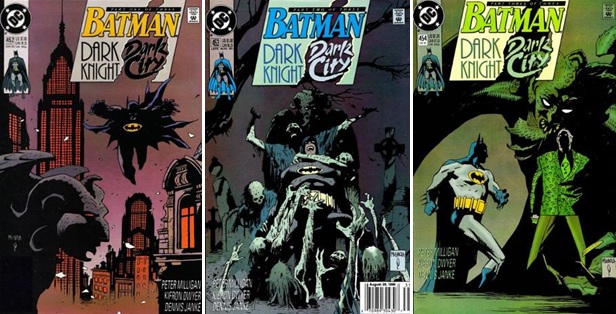
Screenwriter Daniel Waters has cited Frank Miller's The Dark Knight Returns (1986) as having left a strong impression on him:
''I think it's one of the best things done in any medium in the last five years. In fact, I was one of those naïve people who thought 'Why not just make a movie out of Miller's version?' Then you realize that no studio is going to spend $60 million on a movie where five hundred people get killed on The David Letterman Show.'
Considering Waters' fondness for this book, it seems likely it would have influenced his script.
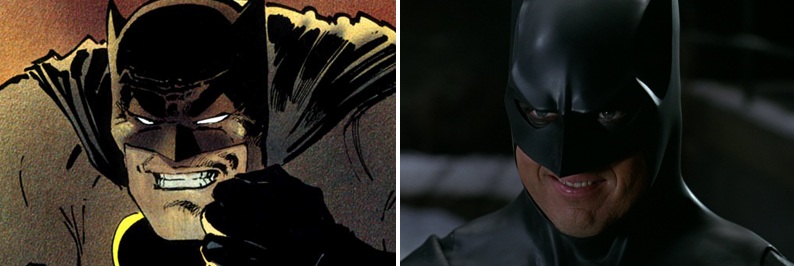
What follows is an in depth analysis of Batman Returns and its relevancy to the comics. Some of these parallels will be deliberate, others coincidental. Several will have carried over from Burton's first Batman film. But regardless of whether they were intentional or not, they are all parallels worth noting.
BATMAN RETURNS AND THE COMICS
When we first see Bruce Wayne in Batman Returns he is sitting in a darkened room, alone, meditating. This depiction of Wayne as an introverted loner is very much in keeping with the early Batman comics, before the introduction of Robin or Alfred. Back then Batman would often be shown sitting up late at night, deeply immersed in thought. The character became less introverted as the years went on. And it wasn't until the seventies and eighties that the classic depiction of Bruce as an uncommunicative loner would be revived. Writer Frank Miller in particular was instrumental in popularising this darker take on the character during the eighties.
A classic moment from Detective Comics #33 (1939) is the scene where Bruce Wayne is sitting up late at night and a bat suddenly flies in through his window. This omen inspires him to adopt the image of the bat to strike fear into the hearts of criminals.
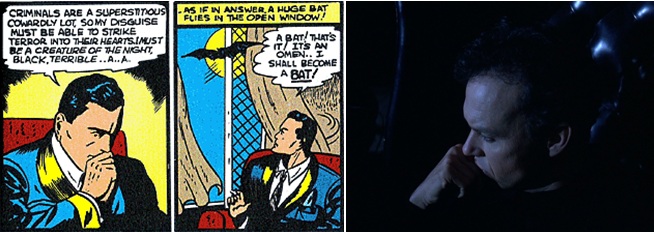
Frank Miller wrote a new variation of this scene in The Dark Knight Returns, where the old retired Bruce Wayne is inspired to resume his crusade after another bat smashes through his window. The image of the Bat-Signal shining in through the window in the movie can be seen as Burton's reinterpretation of this classic moment.
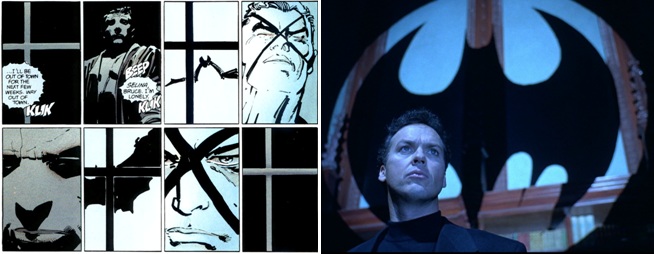
Wayne Manor in the movie is shown to be a large gothic mansion situated several miles outside the city.
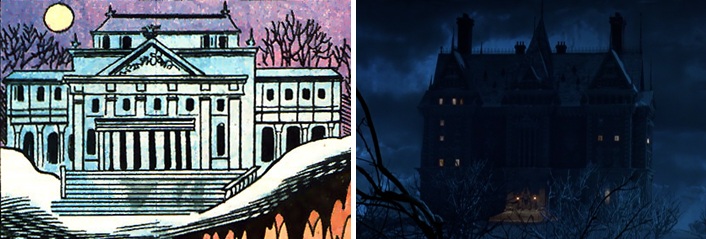
It has mirrors on the roof, specially designed to detect and relay the Batsignal to Bruce's study. This was invented for the movie, but several later comics have shown the roof of Wayne Manor to feature a similar system of mirrors.

The depiction of Gotham City as a gothic, snowbound dystopia is reminiscent of how Frank Miller portrayed it in The Dark Knight Returns.

Gotham is shown to have a Central Park area in the heart of the city. In the comics, this is known as Robinson Park.
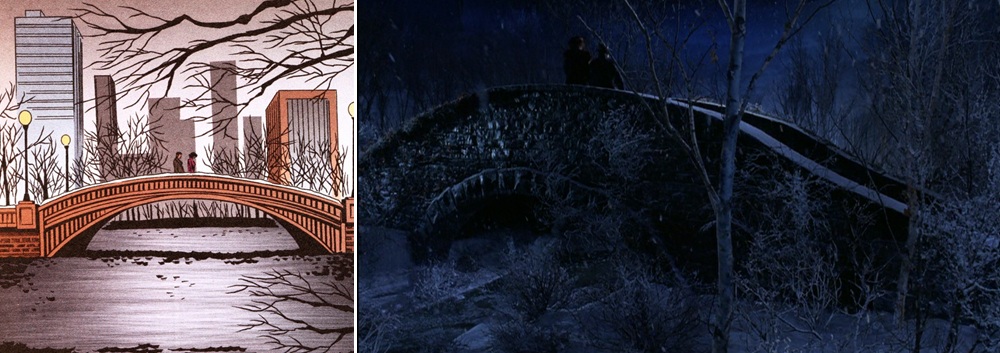
Much of the action in the movie takes place around Gotham Plaza. In the comics, the Gotham Plaza is an upscale hotel in the heart of the city. Some comics have also given the address of City Hall as Number One Gotham Plaza.
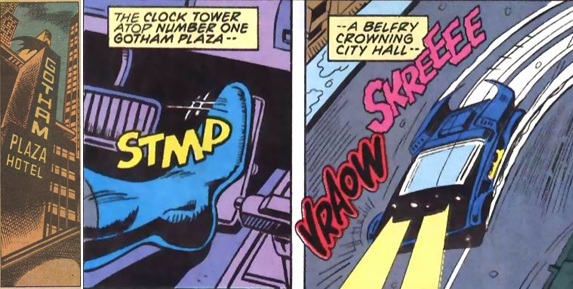
It is here that we are introduced to Alfred Pennyworth, Bruce Wayne's faithful butler. Alfred first appeared in the comics in 'Here Comes Alfred' (Batman #16, April 1943). He is seen throughout the movie performing a variety of domestic tasks such as putting up the Christmas decorations in Wayne Manor, serving Bruce his meals while he works in the Batcave, ironing his clothes, etc. The Alfred in the comics is equally devoted to taking care of his employer. He is Bruce's closest friend and confidant, both in the comics and in the movie.
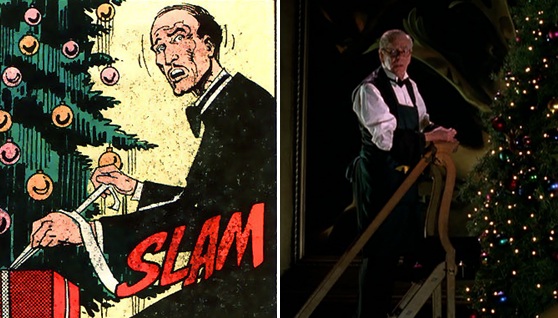
A paperboy tries to sell Alfred a newspaper with a headline about recent penguin sightings in the sewers. Early Batman comics often began with paperboys announcing a recent crime. This example is from Detective Comics #28 (June 1939).

The trouble kicks off when a giant red and green parcel is wheeled into Gotham Plaza and the Red Triangle Gang members emerge from within. This could be a nod to a scene in 'The Penguin Goes A-Hunting' (Batman #17, June 1943) where the Penguin has a trap delivered to a party disguised as a giant red and green gift-wrapped present.
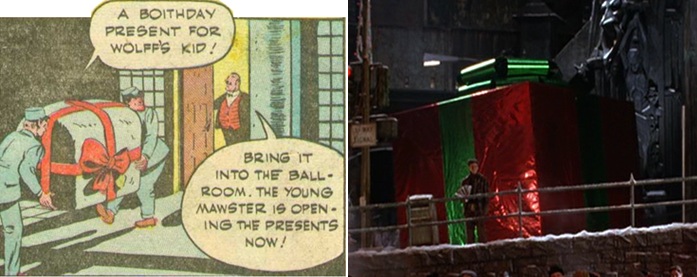
The ensuing riot scene may have been influenced by 'Without Fear of Consequence' (Batman #456, November 1990), in which criminals wearing skeleton masks launch a citywide attack against Christmas shoppers on Christmas Eve.
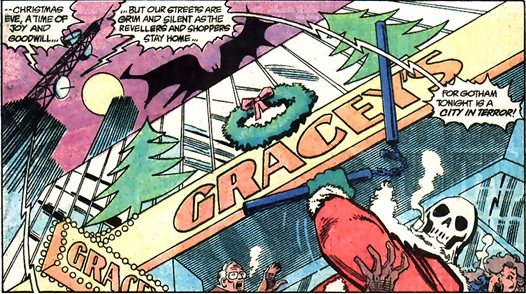
Although the Red Triangle was created for the movie, there have been many similar gangs in the comics over the years. The first time Batman tackled such a gang was in 'The Case of the Joker's Crime Circus' (Batman #4, 1940), in which the Joker carries out nightly crime raids with the assistance of a miniature circus. The gang members include a group of acrobats and shaven-headed strongman.
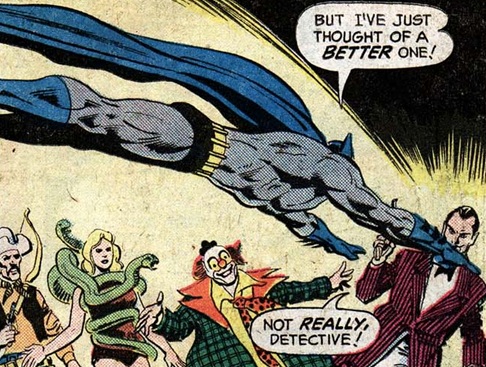 The Joker is not the only villain to have allied himself with crime circuses. Catwoman teams up with criminal members of the Tip-Top Circus in 'Catwoman's Circus Caper!' (Batman #256, June 1974). Meanwhile Ra's al Ghul is revealed to be the head of the Gaston St. Lucifer's Circus gang in 'Bedlam Beneath the Big Top!' (Batman #488, June 1975). His henchmen in this story include acrobats, a clown, a strongman, a sharpshooter, a contortionist, a knife thrower and a snake lady (later revealed to be Talia al Ghul in disguise).
The Joker is not the only villain to have allied himself with crime circuses. Catwoman teams up with criminal members of the Tip-Top Circus in 'Catwoman's Circus Caper!' (Batman #256, June 1974). Meanwhile Ra's al Ghul is revealed to be the head of the Gaston St. Lucifer's Circus gang in 'Bedlam Beneath the Big Top!' (Batman #488, June 1975). His henchmen in this story include acrobats, a clown, a strongman, a sharpshooter, a contortionist, a knife thrower and a snake lady (later revealed to be Talia al Ghul in disguise).
On other occasions, Batman has fought circus gangs unaffiliated with major villains. One such example would be the Wire-Heads in 'The Attack of the Wire-Head Killers' (Batman #302, August 1978), whose members include a magician, a team of acrobats, a strongman, a knife thrower and a fire breather.
Tim Burton has cited Alan Moore's The Killing Joke (1988) as his all-time favourite Batman comic. In this story the Joker employs a group of sideshow performers to do his evil bidding. The scene in Batman Returns where Shreck awakens after being kidnapped, only to find himself surrounded by circus performers, is likely a nod to the scene in The Killing Joke where Gordon awakens to find himself in an equally nightmarish situation.
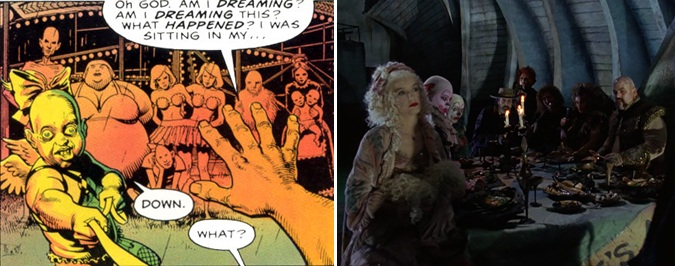
Members of the False Face Society have also been known to wear masks resembling clowns, devils, skeletons and other carnival-themed designs. So while the Red Triangle Gang may have been an original creation, they are nevertheless fairly typical of the type of gangs populating Batman's world.
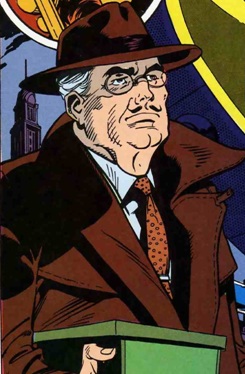 It is during the riot scene that we are introduced to Commissioner James Gordon. Burton's take on Gordon is an accurate representation of the character as he originally appeared in the Golden Age comics. In contrast to the Post-Crisis Gordon, the Golden Age version was already an old man when he debuted in 'The Case of the Chemical Syndicate' (Detective Comics #27, May 1939), and he was already commissioner of the Gotham City police department.
It is during the riot scene that we are introduced to Commissioner James Gordon. Burton's take on Gordon is an accurate representation of the character as he originally appeared in the Golden Age comics. In contrast to the Post-Crisis Gordon, the Golden Age version was already an old man when he debuted in 'The Case of the Chemical Syndicate' (Detective Comics #27, May 1939), and he was already commissioner of the Gotham City police department.
This Gordon was a mature, portly gentleman with glasses and a moustache. Unlike the Gordon in more recent comics, the Golden Age version generally avoided getting involved in the action, instead relying on Batman to do the crime fighting for him. He was very rarely shown leaving his office and his role in the stories chiefly consisted of summoning Batman with the Bat-Signal and briefing him on whatever threat was at hand.
In Detective Comics #58, Gordon is the one policeman who refuses to accept Batman's guilt after the Penguin frames him. Likewise in Batman Returns, Gordon is the only official who maintains faith in Batman after Cobblepot tries to set him up. He cautions the public against jumping to conclusions when presenting the blood-stained batarang on the news, and later he orders his men not to open fire on the Dark Knight.
Gordon is also the only city official that Batman deigns to speak to throughout the entire movie, suggesting he is one of the few people Batman really trusts. Their onscreen relationship is one of mutual confidence, just as it has always been in the comics.
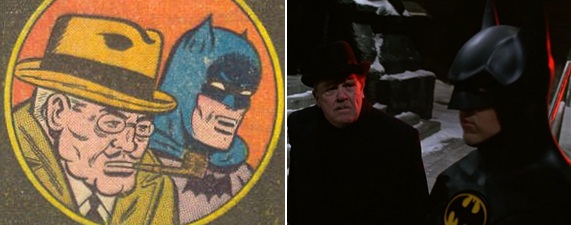
Gordon and his men are unable to quell the riot on their own, and so Batman is called in to help. During the skirmish a pair of gang members jump onto the Batmobile and attempt to shatter the bulletproof windscreen. A similar setpiece occurs in Batman versus Predator (1991), where the titular alien jumps on top of the Batmobile and tries to break the glass. In both stories Batman sets the vehicle in motion, accelerates to a fast speed, then brakes suddenly so that the momentum sends his unwanted passenger(s) flying.
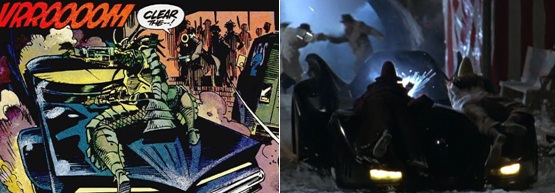
Batman then uses the Batmobile's exhaust flame to set another gang member on fire. This may seem like an uncharacteristically harsh method for the Dark Knight to incapacitate an enemy, but it's not without precedent in the comics. Burton's Batman is largely based on the Golden Age version and the Pre-Zero Hour version that was contemporary at the time the films were made. And during both of those eras, the Batman in the comics demonstrated a willingness to use lethal force in his war against crime.
A few examples of Batman killing during the Golden Age era:
- In Detective Comics #27 he punches a criminal into a vat of acid
- In Detective Comics #30 he breaks a criminal's neck with a well-aimed kick
- In Detective Comics #32 he shoots Dala and the Monk with a pistol will they are asleep
- In Batman #1 he shoots a van full of criminals with the machine guns aboard the Bat-Plane and hangs another criminal from a rope
- In Detective Comics #39 he crushes a gang of criminals beneath a giant statue
- In Batman #6 he throws a criminal off an oil derrick
- In Detective Comics #55 he throws a villain into a vat of molten steel
A few examples of Batman killing during the Pre-Zero Hour era:
- In Son of the Demon (1987) he knocks Qayin into some cables, electrocuting him
- In The Cult (1988) he uses the Batmobile's armaments to demolish a building in order to kill the snipers on the rooftop
- In Batman #420 he tries to trap KGBeast in the sewers and leaves him to starve/suffocate (later retconned)
- In Detective Comics #590 he crashes a car into a group of terrorists and blows them all up
- In Batman #425 he crushes a criminal by toppling a pile of cars on top of him
- In Cosmic Odyssey (1988) he kills one of Darkseid's henchmen using an Apokoliptian gun
- In Detective Comics #595 he demolishes a factory filled with alien soldiers
- In Legends of the Dark Knight #31 he blows up a weapons cache and the sentries guarding it
These are just a few examples illustrating the inconsistency in Batman's moral code; in particular during the eras from which Burton was drawing most of his inspiration. The scene where the fire breather is immolated is therefore not as out of character as some people might assume. It also echoes the scene in The Dark Knight Returns where Batman rigs a trap that sets an innocent cop on fire.
Batman deploys a variety of weapons during his fights against the Red Triangle Gang. The grapple gun was a gadget that was invented specifically for Burton's first Batman film. By time Batman Returns was in production, it had made numerous appearances in the comics.
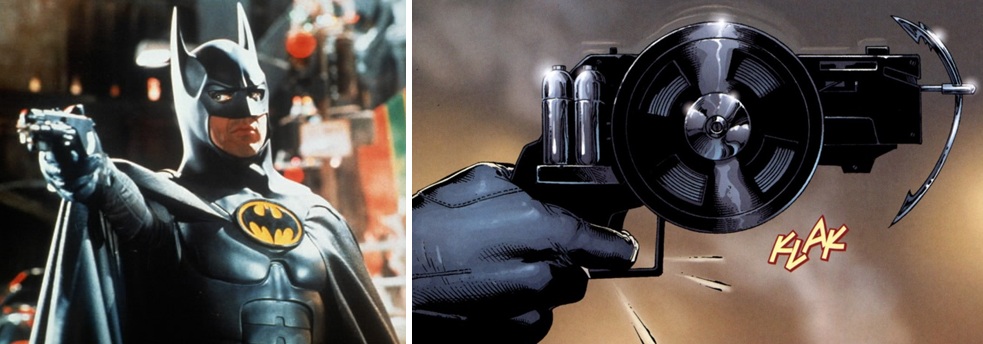
Some new gadgets were introduced in Batman Returns that were also later adapted into the comics, including the double grapple gun/line launcher...
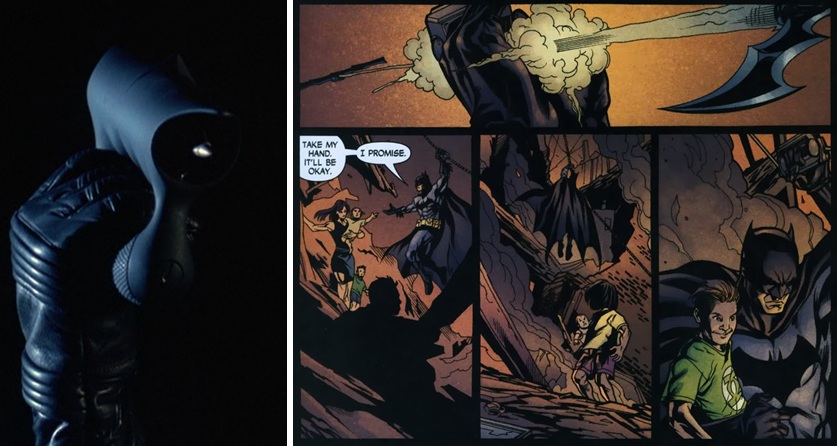
...and the programmable batarang.
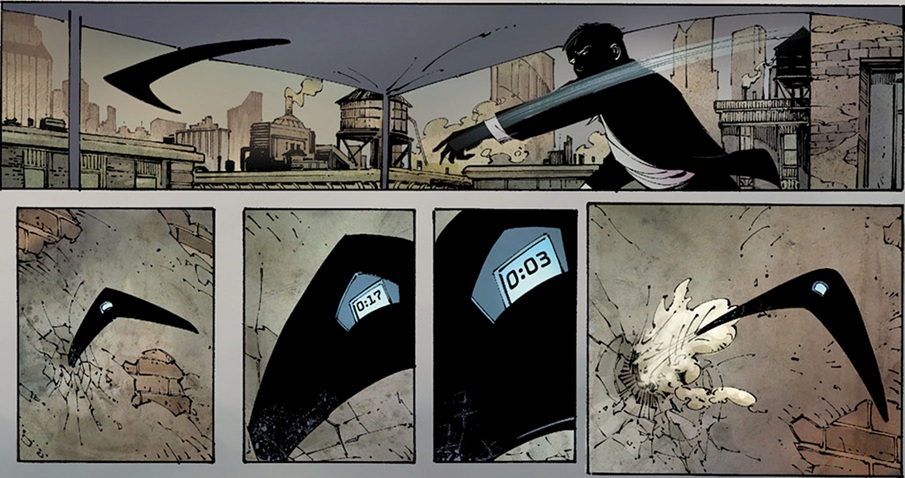
After the riot, our attention shifts to an abandoned zoo where the Penguin's lair is situated. The idea of the villiain setting up their base in an abandoned amusement park may have been inspired by The Killing Joke. Alternatively, it could be a reference to Alan Grant's 'The Killing Peck' (Secret Origins Special #1, 1989), in which the Penguin holes up in an empty enclosure within Gotham Zoo. The plot of 'The Killing Peck' sees Cobblepot kidnapping a bully who'd tormented him as child and taking him back to his hideout in the zoo to torture him. Shreck is subjected to a similar abduction in the film.
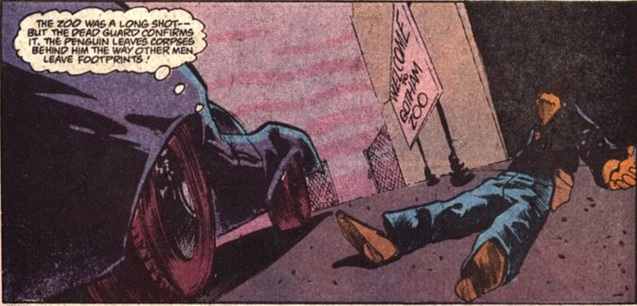
It is then that we are introduced to the film's central villain: the Penguin. Burton's version of the Penguin was a departure from the version in the comics at the time, most notably due his physical deformities. In Batman Returns, Oswald Cobblepot is depicted as having pale skin, pointy teeth and fused digits on his hands (syndactyly). However, many subsequent comics have shown the Penguin to have these exact same afflictions.

Even before the movie came out, the Cobblepot in the comics was depicted as having an abnormal physical appearance. He has always been unusually short and fat with a beak-like nose. He even self-identifies as a "freak" in The Penguin Affair (1990), foreshadowing his line in the movie: "You're just jealous because I'm a genuine freak and you have to wear a mask!"

The Pre-Crisis Penguin also had a near-metahuman ability to endure freezing temperatures. This is most memorably portrayed in ‘C-c-cold!’ (Detective Comics #541, August 1984), in which Batman almost freezes to death in Antarctica while the Penguin flaunts a bizarre immunity to the subzero climate.
His preference for cold environments dates back to the comics of the forties. In some Golden Age stories he was even shown to have specially refrigerated hideouts inhabited by real penguins. His lair in the movie would appear to have been modelled on such locales.
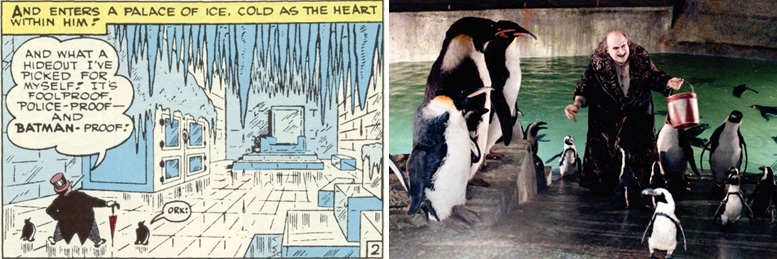
Burton's Cobblepot displays several other animalistic characteristics in common with his comic book counterpart. He has a habit of squawking like a bird when excited and is shown to have an appetite for raw fish. The Pre-Crisis Penguin also ate raw fish, as demonstrated by this example from 'Hail Emperor Penguin!' (Batman #257, August 1974).
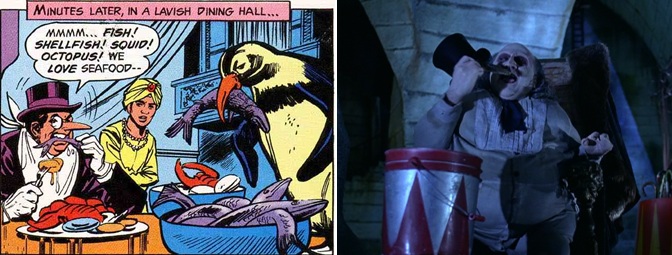
His posturing and pretentious speech is also typical of the Penguin in the comics, as is his use of weaponised umbrellas. Over the course of the film we see him wield several such lethal umbrellas:
- A flamethrower umbrella
- A swirling disc umbrella
- A helicopter umbrella
- A retractable blade umbrella
- A machine gun umbrella
These have all appeared in the comics at some time or other.
In addition to his umbrellas, Cobblepot also has another signature gadget in the movie: a mechanical vehicle shaped like a giant duck. This is probably a reference to the Pre-Crisis Penguin's habit of riding around on giant birds or mechanical/robotic vehicles designed to resemble them.
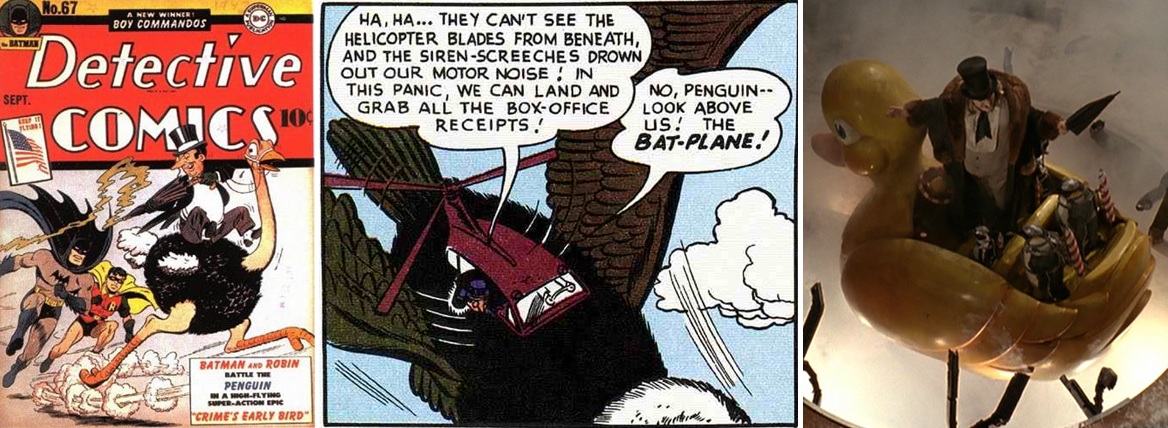
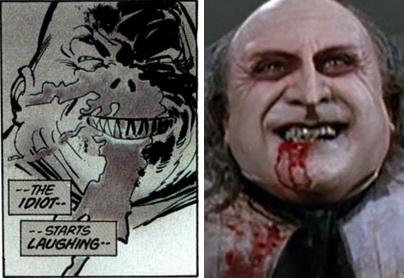 Cobblepot's background as a freak show performer is similar to that of the comic villain Killer Croc/Waylon Jones, whose freak show origins were revealed in 'Hunt' (Batman #359, May 1983). Also in this issue are scenes showing Killer Croc spying on people through sewer grates the way Cobblepot does in the movie.
Cobblepot's background as a freak show performer is similar to that of the comic villain Killer Croc/Waylon Jones, whose freak show origins were revealed in 'Hunt' (Batman #359, May 1983). Also in this issue are scenes showing Killer Croc spying on people through sewer grates the way Cobblepot does in the movie.
Another bestial comic villain who may have influenced Burton's interpretation of the Penguin is the Mutant Leader from The Dark Knight Returns. Like Cobblepot, the Mutant Leader sported freakish pointy teeth and was in command of the most feared street gang in Gotham. Both he and Cobblepot use television interviews to issue challenges to Batman and the city officials.
The Penguin's origin story in the movie is different from the one in the comics at the time. The Pre-Crisis Penguin’s back story was depicted in ‘The Origin of the Penguin’ (Best of DC #10, March 1981). In this story we learn that Oswald’s father died from bronchial pneumonia when he was very young. His invalid mother provides for him by running the family bird shop. But her medical expenses deplete what little money they have. Following her death, the Cobblepot bird shop is possessed by repo men. With no other source of income, Oswald turns to a life of crime and becomes the Penguin.
The Post-Crisis Penguin’s backstory is told in ‘The Killing Peck’ and is pretty much the same as the Pre-Crisis version, except with more of an emphasis on the bullying aspect. It explains how he gets the nickname ‘Penguin’ from a bully called Sharkey, who is also responsible for killing all the birds in Oswald’s pet shop.
Batman Returns present a completely different version of his origin. In the movie, the Cobblepots are reimagined as a wealthy family not unlike the Waynes. They reject their son upon seeing his hideous appearance, consigning him to a life of exile and denying him his aristocratic birthright. Consequently Oswald grows up resenting his parents and the rich aristocratic clique they represent. He yearns to fit in with that social stratum, but at the same time, yearns to destroy it as revenge for the way it rejected him.
In recent years, the Penguin's origin in the comics has been modified to bring it more in line with the movie. In Gregg Hurwitz's Penguin: Pain and Prejudice (2011-2012) the Cobblepots are depicted as a rich aristocratic family, just like in Batman Returns. We also see the moment of Oswald's birth and his father's horrified reaction upon seeing him for the first time. In the movie he simply screams. In the comic he literally drops the infant in disgust.
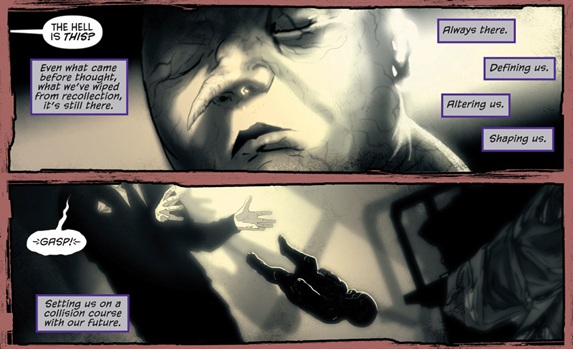
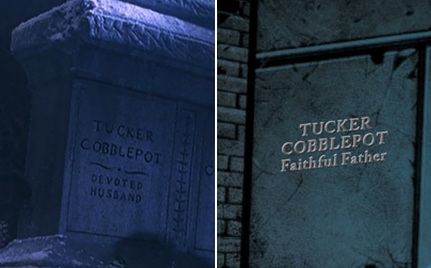
In the film, Oswald's parents abandon him in the river in Gotham Park. In the comic, their reaction is less extreme and they tolerate his presence in the family home. But Tucker emotionally rejects and mistreats his son. As a result of his father's cruel disregard towards him, Oswald grows up an emotionally-scarred outcast.
Incidentally, the character of Tucker Cobblepot was created especially for the movie. Oswald's father had never appeared in any comics prior to the film's release, nor had he ever been named. Tucker was finally adapted into the comic canon in Hurwitz's Penguin: Pain and Prejudice.
The Penguin's narrative in Batman Returns loosely follows his very first story in the comics, 'One of the Most Perfect Frame-Ups' (Detective Comics #58, December 1941). When the Penguin first appears in this story he is perceived by the people of Gotham as a harmless, odd looking man named Mr. Boniface. He quickly contacts the biggest racketeer in Gotham and the two men forge an alliance.
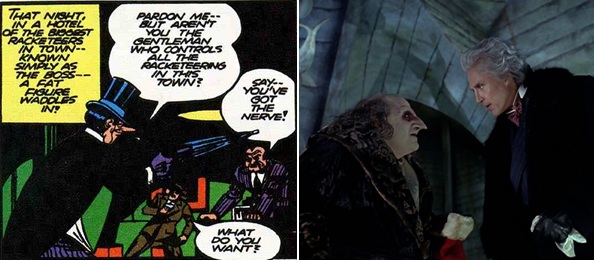
The Penguin then proceeds to orchestrate a crime wave from behind the scenes, taking care to conceal his own involvement from the public. Bruce Wayne starts to suspect a connection between the Penguin's arrival in Gotham and the recent increase in criminal activity, but he can't prove it.
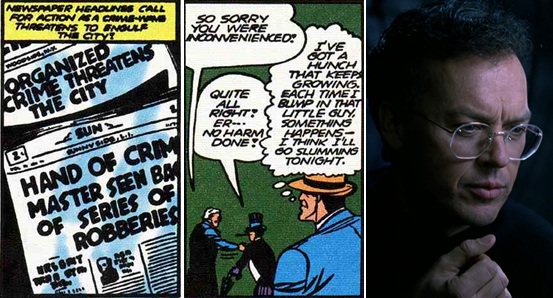
The Penguin's henchmen attempt to pull off their latest crime, only for Batman to show up and stop them in the act. The Penguin then makes his presence known, thereby confirming Batman's suspicions that he is the mastermind behind the crime wave.
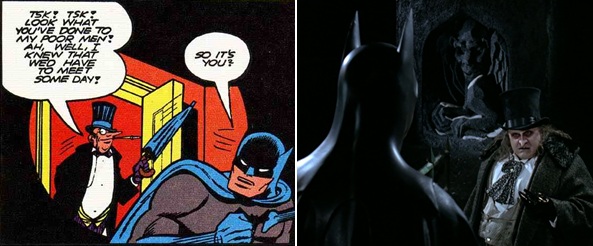
Realising Batman will continue to foil his schemes, the Penguin hatches a plan to frame the Dark Knight for a crime he didn't commit.
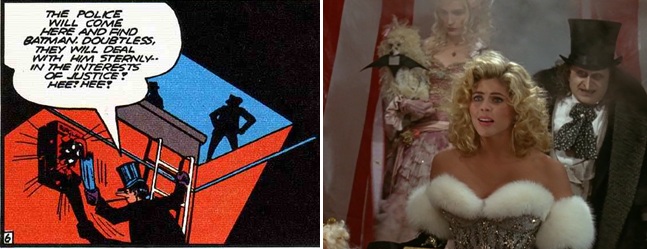
The plan initially works and the police turn against Batman.
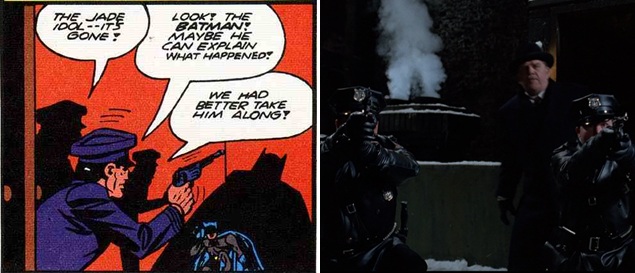
Eventually the Penguin's true nature is exposed to the world and he is forced to flee from the authorities. Batman chases him down and the two of them fight one last time. After the Penguin's true villainy becomes known, Batman is exonerated of the charges against him. We don't see Batman's name cleared in the movie, but we can assume his reputation is restored once Cobblepot's evil agenda is made known.
The second major villain Batman Returns is Max Shreck. This character is essentially Burton's version of the comic villain Rupert Thorne.

The first time we see Thorne in 'By Death's Eerie Light' (Detective Comics #469, May 1977) he's in a meeting with some of the city councilmen, negotiating tax incentives to facilitate the construction of a new power plant. The first time we see Shreck in Batman Returns he's in a similar meeting, also proposing the construction of a new power plant.
In both stories the power plant meets serious opposition. Thorne and Shreck both resort to underhanded electioneering to try and win favour with the public and allow their plans to go ahead. However, their efforts are not entirely successful in either story. Thorne's power plant is eventually built, but he is forced to construct it outside the city limits, three miles offshore. And it ends up proving to be a financial disaster. Meanwhile Shreck's power plant is never built at all.

Thorne's second big storyline in Strange Apparitions (1977-1978) sees him having Hugo Strange killed, only for his victim to return from the grave to vengefully haunt him. This is somewhat similar to the storyline between Shreck and Selina in the movie. Shreck thinks he has killed Selina, but like Hugo Strange, she turns out to have survived the attack and subsequently hounds him in search of revenge.
Thorne's next big scheme, starting in 'The Ghost of Wayne Mansion' (Batman #341, November 1981), sees him trying to gain political power by backing a corrupt candidate in the mayoral elections. He successfully campaigns to get one of his stooges, Hamilton Hill, elected as mayor of Gotham City. Thorne is then able to control Hill's administration to serve his own agenda. Shreck attempts the same strategy in Batman Returns, putting Cobblepot forward as a candidate to supplant the current mayor. Both Thorne and Shreck engineer smear campaigns against Batman as part of their political strategy.
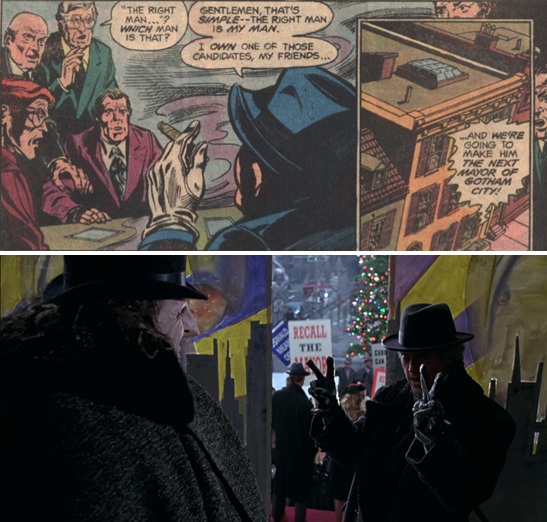
Thanks to the machinations of Thorne, Hamilton Hill becomes mayor of Gotham in 'The "I" of the Beholder' (Detective Comics #511, February 1982). Cobblepot comes close to being mayor, but is ousted in the final stage of his campaign.
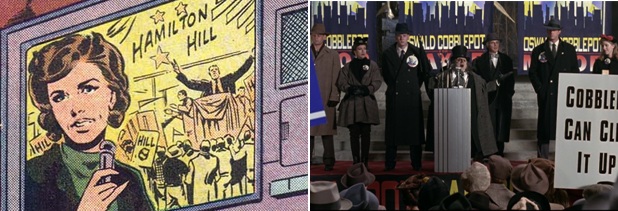
Hill, like Cobblepot, tries to frame Batman for a crime in order to turn public opinion against him. In 'Hill's Descent' (Detective Comics #546, January 1985), Hill uses a replica of Batman's glove to incriminate him. In the movie, Cobblepot uses one of the Dark Knight's batarangs to set him up.
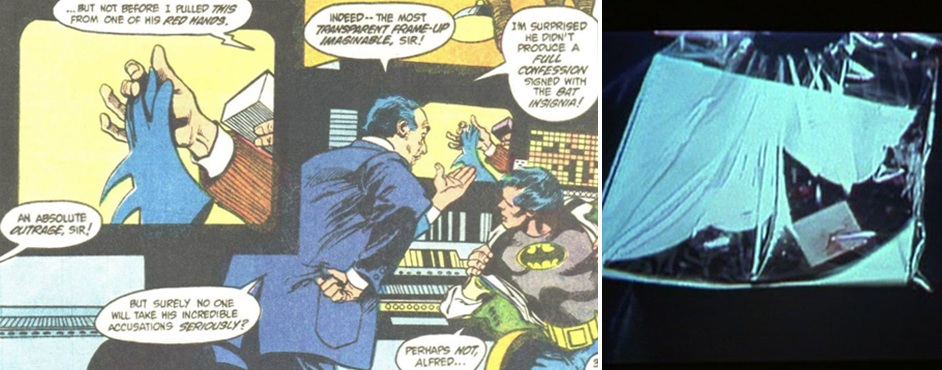
Ultimately Batman is able to end both Hill and Cobblepot's political careers by exposing their corrupt nature to the public. Rupert Thorne is imprisoned in the comics, while Max Shreck meets his demise at the hands of Catwoman.
The political storyline in the movie is also indebted to a couple of episodes of the 1960s Batman TV show – 'Hizzoner the Penguin' and 'Dizzoner the Penguin' – in which the Penguin attempts, unsuccessfully, to become mayor of Gotham City.
The Cobblepot family has developed additional ties to the mayor's office in more recent comics. Oswald's great-grandfather, Theodore Cobblepot, is said to have served one of the longest and most successful terms as mayor of Gotham during the late 19th century. Theodore is first mentioned in Gotham Underground (2008) and later features more prominently in Batman: Gates of Gotham (2011). Oswald himself becomes mayor of Gotham during an ongoing story arc in Batman Adventures #1-13 (2003-2004). He is also depicted as the mayor in Geoff Johns' Batman: Earth One (2012).
Midway through the movie, Bruce Wayne goes to a meeting with Shreck to discuss the political ramifications of the latter's proposed power plant. Bruce uses this meeting as an opportunity to bait Shreck on the subject of Cobblepot's criminal status; successfully getting a rise out of the mogul and thus confirming his theory about the Penguin's involvement in the Red Triangle Gang attacks. The Bruce Wayne in the comics will frequently use his status as a businessman to influence political events and gather information pertinent to his crime fighting activities, just as we see him do in the movie.
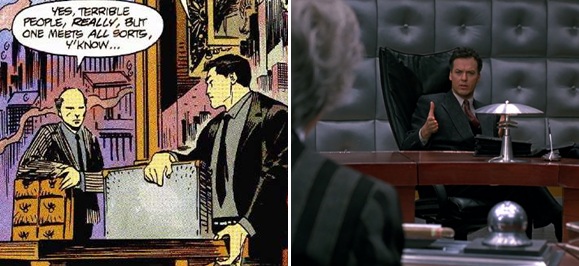
It's during this meeting that Bruce meets Shreck's secretary, Selina Kyle. As in Burton's first Batman film, Bruce is shown to be slightly nervous around women he's attracted to. This character trait was occasionally referenced in the comics following the release of the 1989 film. Bruce would sometimes behave it a jittery or distracted manner when talking to dates, as illustrated by this example from 'Trash' (Detective Comics #613, April 1990).
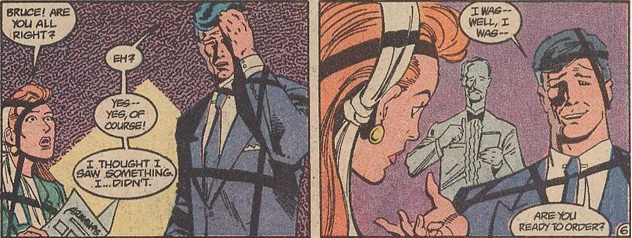
Burton's take on Catwoman's origins is basically a mixture of her back stories from the Golden Age and Pre-Zero Hour comics.
When Catwoman first appeared in 'The Cat' (Batman #1, Spring 1940) she had no origin story or alter ego. She was simply a femme fatale in a green dress, known only as 'the Cat'. The name Selina Kyle wasn't introduced until 'The Secret Life of the Catwoman!' (Batman #62, December 1950). In this story it is revealed that Catwoman was previously an air stewardess who fell out of a crashing airplane and banged her head. The fall left her with amnesia and sent her into a fugue state, wherein she became Catwoman.
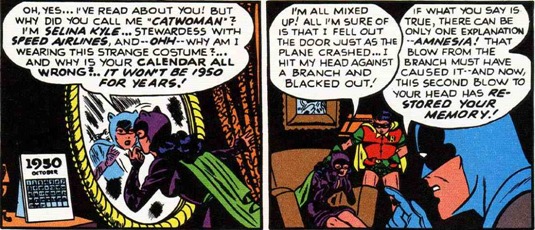
This origin was later retconned during the Bronze Age story 'The Autobiography of Bruce Wayne' (Brave and the Bold #197, April 1983). Here, Selina reveals that the story about her being an air stewardess with amnesia was all a lie. Her true back story is that she was once the trophy wife of a cruel but wealthy businessman who used to beat her. Eventually Selina left her husband and avenged herself against him by breaking into his office and stealing the jewels from his safe. She then discovered she had an appetite for crime and continued her criminal career as Catwoman.
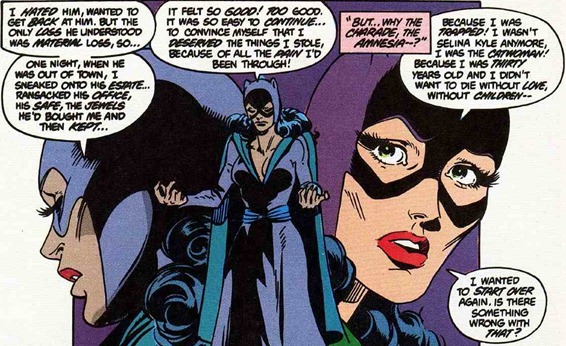
It's worth noting that this second origin story only applies to the Earth-Two version of Catwoman. The amnesia origin story from Batman #62 still applies to the Earth-One Catwoman of the Silver and Bronze Age comics.
Selina also claims to have amnesia in Batman Returns when she shows up during Bruce and Max's meeting. But as in the Earth-Two comics, this is merely a lie to conceal what really happened. In truth she was pushed out of a window by her boss, Max Shreck. From this we can already see how elements of the two Pre-Crisis origins have been implemented: firstly, that Selina entered her Catwoman mental state after suffering a near death experience that resulted in head trauma (falling out of a crashing plane/falling from a window in Max's office); secondly, that her transformation into Catwoman was an act of emancipation so she could avenge herself against a domineering male figure who'd previously abused her (her husband/her boss).
This pattern is also evident in the 1989 Catwoman Volume 1 miniseries by Mindy Newell, J. J. Birch and Michael Bair. Later collected in trade paperback form as Catwoman: Her Sister's Keeper, this was Catwoman's canonical origin story at the time Batman Returns was made and was specially reissued in 1992 to coincide with the film's release.
Catwoman: Her Sister's Keeper begins with Selina being raped, brutally beaten and left for dead in an alleyway by her pimp, Stan. The scene in the movie where the cats inspect Selina as she lies motionless in the alleyway, teetering on the brink of death and bathed in cold moonlight, would appear to have been adapted directly from this book. In both the movie and the comic, this scene is the turning point that triggers Selina's journey to becoming Catwoman.
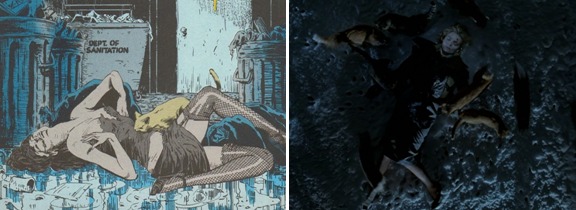
Artists Michael Bair, who worked on Catwoman: Her Sister's Keeper, mentioned the comic's influence on this scene in the movie on his page at Comic Art Fans.com.
"This is the scene that was copied in both Batman Returns & Catwoman movies, where the dead body is surrounded by cats."
Of course Selina survives in both the comic and the movie, and subsequently embarks on a quest for revenge against the man who almost killed her. This new variation on Selina's origins has clear parallels with the Pre-Crisis versions: Selina becomes Catwoman after surviving a near-death experience, and initially does so in order to get revenge on the man responsible. But now Selina is depicted as a prostitute, a working girl, and the domineering male figure in her life is her boss instead of her husband. This more contemporary approach to her origins is reflected in the movie.
It's interesting to note that before the air stewardess alter ego was introduced in 1950, Catwoman had already had several other secret identities. In 'The Princess of Plunder' (Batman #10, April 1942) she operates under the guise of a rich socialite named Marguerite Tone. In 'Your Face is Your Fortune' (Batman #15, February 1943) Catwoman's alter ego is that of a salon worker named Elva Barr. Elva is a working girl who lives alone in a small apartment with her cat and is constantly talking to herself. Her characterisation is remarkably similar to the movie version portrayed by Michelle Pfeiffer.

The Elva Barr alter ego was arguably the first to portray Catwoman as a fully rounded character. This was the first time she was shown to have an ordinary life away from her criminal activities, with her own modest apartment and a legitimate daytime job. It was also the first comic to show Bruce Wayne romancing Catwoman's real self as opposed to simply flirting with her costumed persona.
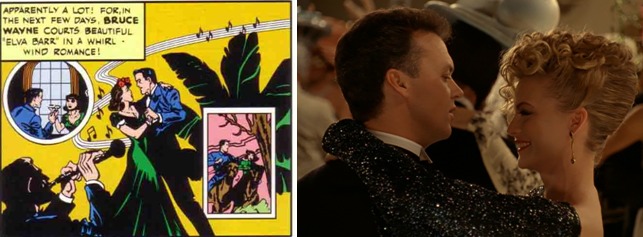
Selina Kyle reformed during the latter part of the Golden Age and began a law-abiding life working in a pet shop. During this period she was depicted as an honest and hard working woman, constantly struggling against the traumatic memories of her criminal past. In contrast to the urbane socialite Selina of modern comics, the Golden Age version was mostly depicted as a down-to-earth middle-class woman, often at odds with her duel identity. This characterisation has clear parallels with the version we see in the movie.
While Selina Kyle is nowadays portrayed as a brunette, her hair colour was not always consistent in the Pre-Crisis comics. And during the Golden Age in particular she was sometimes drawn as having fair hair like the movie version.
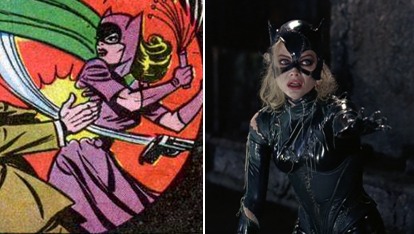
Even when she was drawn with dark hair, Selina would often wear blonde wigs in order to disguise herself. Here's an example from Wonder Woman #201 (August 1972).
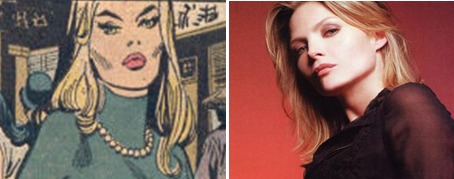
Her costume in the movie is similar to the one she was wearing in the comics at the time the film was in production. It consists of a skin-tight suit, gloves, high heel boots and a cat-eared cowl. According to Batman: Year One and Catwoman: Her Sister's Keeper, Selina had seen Batman in action and was inspired by him to make her own costume. The movie Selina also saw Batman in action and made her costume following his example.
The scene where Selina destroys her stuffed toys might have been influenced by a scene in 'Ebon Masquery' (Batman #387, September 1985) where Roman Sionis destroys his own collection of stuffed toys. In both stories, the act symbolises the death of the character's former self and the beginning of their new life as a masked villain.
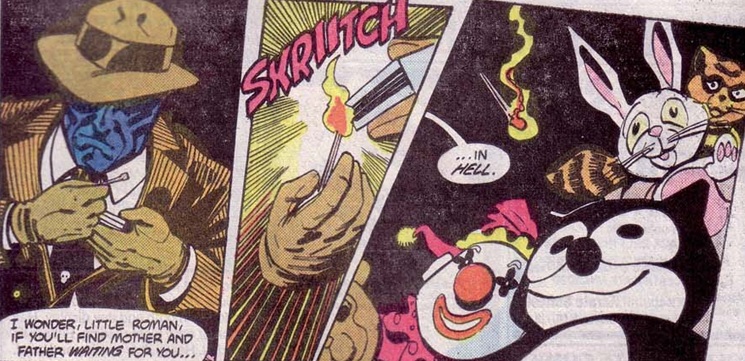
As mentioned earlier, Catwoman's origin/revenge narrative in this film appears to have been adapted from Catwoman: Her Sister's Keeper. Her first costumed exploit in the film sees her rescuing a woman from a rapist in an alleyway. This mirrors her first costumed battle in the comic, where she fights Stan in an alleyway and scratches his face with her claws.
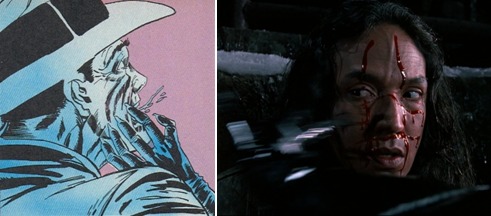
This scene could also be a reference to 'It's a Man's World' (Batman #460, March 1991). Catwoman's first appearance in this comic sees her rescuing a woman from a gang of rapists in an alleyway, slashing the faces of the attackers and afterwards chiding the woman for carelessly placing herself in harm's way.
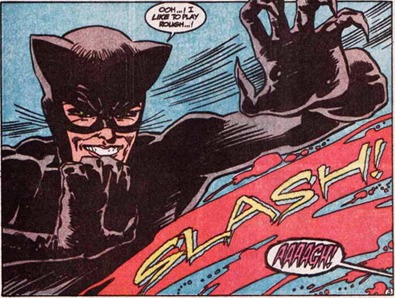
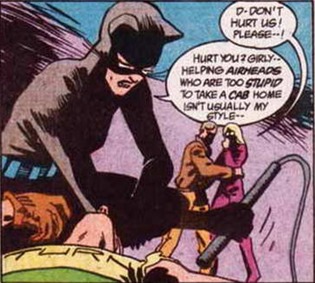
In the Pre-Crisis comics Catwoman's methods varied from story to story. Sometimes she was depicted as a femme fatale, other times as a morally ambiguous ally for Batman. Sometimes she went after money and jewels, other times she simply pulled off novelty crimes themed around cats. Sometimes she was depicted as a gang leader who sent minions to do her work, other times she was depicted as a hands-on criminal who operated alone.
While cat burglary doesn't play an important part in the objectives of Burton's Catwoman, she does nevertheless display thievish skills throughout the film. Early in the movie Selina is able to access Shreck's protected files without his permission. Later she manages to break into Shreck's department store without triggering the alarm, seeing off a pair of inept security guards in a manner typical of her comic counterpart.
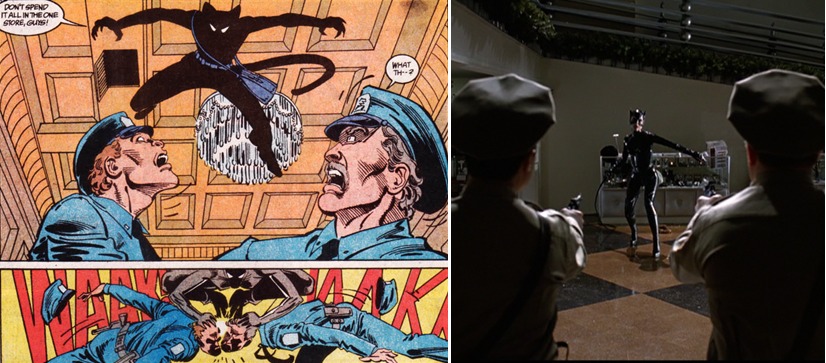
The scene with the security guards in Shreck's department store is also very similar to a scene from Batman: Shaman (1989-1990). In this story Batman is caught intruding at night time by a pair of security guards. He casually disarms the two men, cracks a joke about their wages and then allows them to run away unharmed.
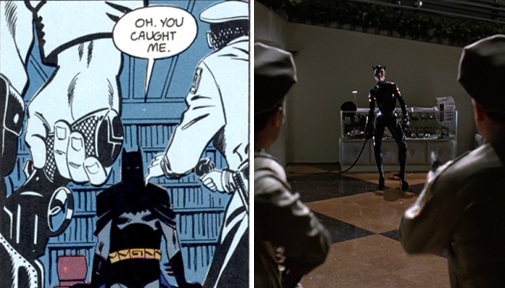
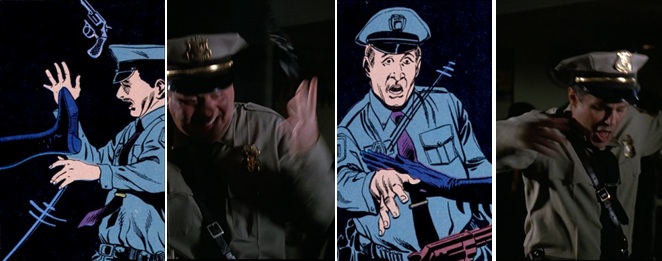
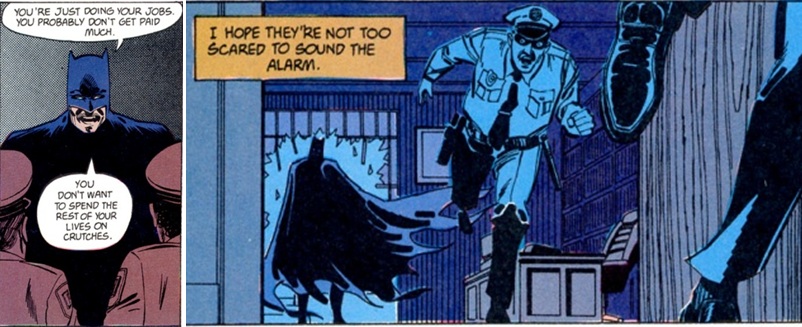
Just before the department store blows up, Catwoman says "meow" to Batman and the Penguin. In the Pre-Crisis comics Catwoman would sometimes use "meow" as a codeword to signal to her henchmen.
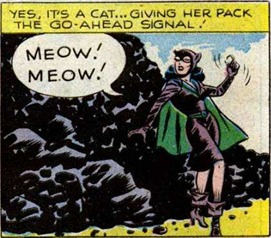
We then see Catwoman scaling the side of a building using her claws.
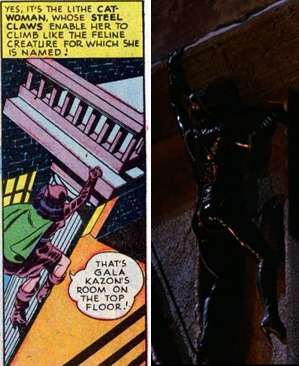
Batman quickly pursues Catwoman up onto the roof. Their first fight scene in the movie mirrors their first encounter in Catwoman: Her Sister's Keeper. In both stories they meet for the first time on a rooftop. Catwoman uses her femininity to lull Batman into a false sense of security before suddenly unleashing a flurry of blows against him.
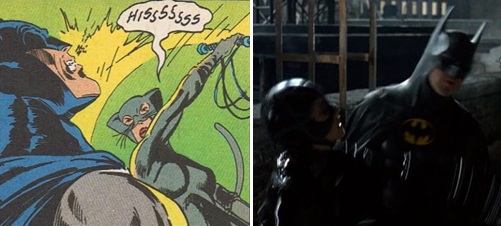
During the fight, Batman produces a napalm capsule from his utility belt and hurls it at Catwoman. He's used similar chemical weapons in the comics on numerous occasions, as demonstrated by this example from The Dark Knight Returns (1986).
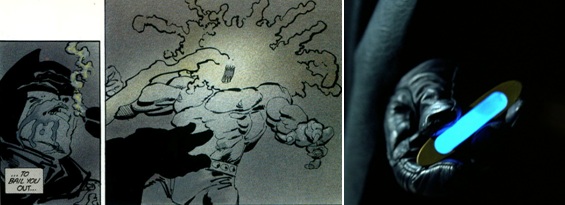
Their fight ends the same way in both Batman Returns and Catwoman: Her Sister's Keeper: with Catwoman clawing the Dark Knight and leaving her mark on him.

In the movie Batman punches Catwoman off a ledge, only for her to land in a truck full of kitty litter. The exact same thing happened in 'The Mad Hatter Goes Straight!' (Batman #297, March 1978) when Batman punched a criminal off a cliff, only for him to land in a truck full of sand and be carried safely away.
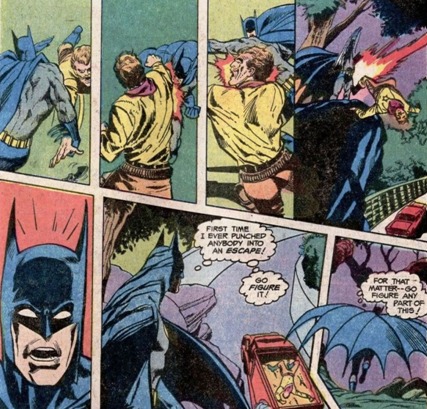
Catwoman attributes her good luck to her feline totem, counting down how many lives she has left each time she escapes death. On Page 16 of Michael Singer's Batman Returns: The Official Movie, writer Bob Kane cites the nine lives myth as a primary reason for choosing the cat motif in the first place:
Why a cat? "Well a cat has nine lives," Kane emphasizes. "So I figured that whenever she was caught, or wounded, she would survive and live again for another go-round with Batman."
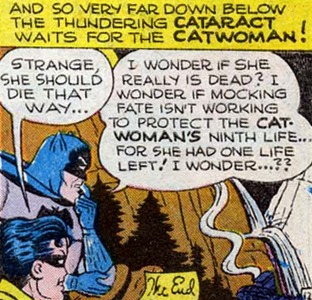 Early Catwoman stories often ended with her plunging into the sea, or disappearing after a vehicular wreck, only to return unscathed a few issues later. The idea of her having nine lives was frequently referenced in an offhand manner.
Early Catwoman stories often ended with her plunging into the sea, or disappearing after a vehicular wreck, only to return unscathed a few issues later. The idea of her having nine lives was frequently referenced in an offhand manner.
On other occasions the nine lives motif played a more central role in Catwoman's capers. An early example of this would be the Golden Age story 'Nine Lives Has the Catwoman' (Batman #35, June 1946), in which Catwoman survives a sequence of life-threatening encounters by virtue of trickery and simple good luck. Each time this happens, she counts down how many lives she has remaining.
She loses her first life after being shot, her second after having a knife thrown at her and her third after falling from a dirigible during a fight with Batman. She then pulls off a series of crimes and loses a further four lives in the process: one from a gunshot, one from a burning building, one from a car crash, and one more from another gunshot. The story ends with Catwoman driving a tractor off a cliff and Batman reflecting that she still has one life left.
Another memorable comic to explore the nine lives theme was the Silver Age story ‘The Case of the Purr-loined Pearl!’ (Batman #210, 1969). Here Catwoman recruits eight recently paroled female felons, dresses them in Catwoman costumes and trains them to move and fight like she does; thus creating eight additional lives to aid her in her crimes.
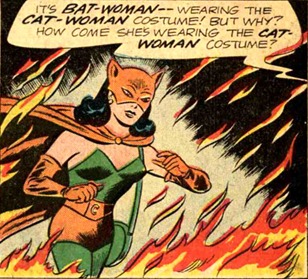
Perhaps the most extensive exploration of the nine lives motif was the Cat-Man story arc that began in 'The Challenge of the Cat-Man!' (Detective Comics #311, January 1963). While previous stories based around this theme had offered rational explanations for the nine lives, this story arc presents them as purely supernatural. Cat-Man's costume had been made from a material taken from a Pacific island on which the natives worshiped cats. Consequently, it bestowed its wearer with extra lives that allowed them to cheat death nine times.
Cat-Man loses his first life in Detective Comics #311 and his second life at the end of ‘The Cat-Man Strikes Back’ (Detective Comics #318, August 1963). He squanders an additional three lives in ‘The Strange Lives of the Cat-Man’ (Detective Comics #325, March 1964). Kathy Kane then assumes the mantle of Catwoman, wearing a costume made from the same material as Cat-Man's and using up three of his remaining lives. Sixteen years later, Cat-Man's last life would be stolen by Selina Kyle in ‘The Cat Who Would Be King!' (Batman #324, June 1980). Cat-Man would return in 'Nine Lives Has the Cat' (Detective Comics #509, December 1981) to try and take Selina's life as revenge for the one she stole from him.
In Batman Returns, we are never told if Selina's nine lives are the product of simple good luck or some supernatural agency. Either way, the concept has numerous precedents in the comics.
Meanwhile, back at the Batcave, Batman asks Alfred to bring him some antiseptic ointment to treat his injuries. In the comics, Alfred is an experienced field surgeon and often helps patch up Bruce's wounds.
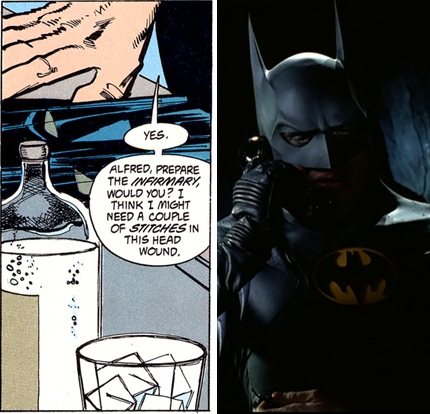
Angered by her defeat at the hands of Batman, Catwoman enters into an alliance with the Penguin. The shot of her reclining with her black cat beside her while she plots her latest scheme is typical of the Golden Age comics. Almost every Catwoman story from that era features such a panel.
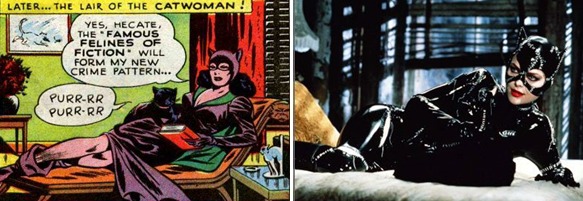
Catwoman and Penguin briefly teamed up in 'The Catwoman's Black Magic!' (Superman's Girlfriend Lois Lane #70, November 1966). As in the movie, their union was characterised by betrayal and unrequited affection. The 'Catwoman' in the panels below is actually Lois Lane acting under the hypnotic influence of the real Catwoman. But since Selina was controlling Lois's actions, and since the Penguin believed she was the real Catwoman, we believe the parallel is still valid.
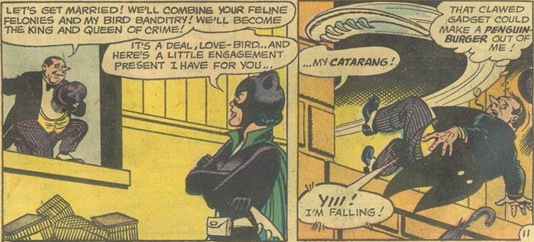
Their scheme in the movie is to frame Batman by kidnapping a local celebrity known as the Ice Princess. The Ice Princess was an original character created for the movie. Her costume visually resembles those of several ice-themed female DC characters, such as Sigrid Nansen/Icemaiden and the JLA villain Frostbite.
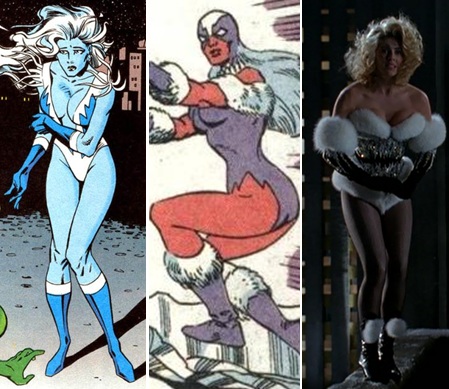
The Penguin also kidnaps a blonde actress in The Penguin Affair (1990), though the context behind the kidnapping was different from in the movie.
Bruce Wayne learns about the kidnapping when it is reported on the evening news. Similar news reports are used to relay information throughout the film: the Penguin's rescuing of the mayor's baby, his challenge to the mayor to relight the Christmas tree, and his political speech where he's pelted with vegetables. Television news reports are used in a similar manner throughout The Dark Knight Returns. In both the comic and the movie, they add a satirical dimension to the plot that parodies the media while also conveying important plot points to the reader/viewer.
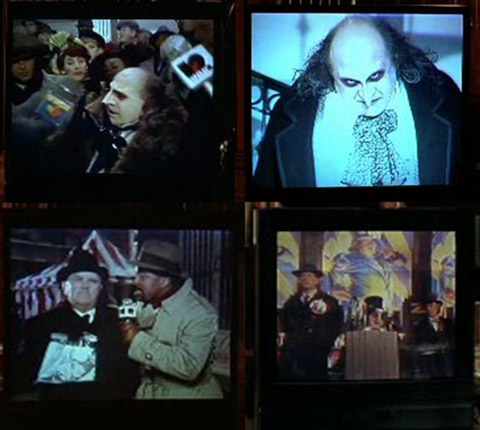
The trap is sprung and Batman is framed for the killing of the Ice Princess. The Dark Knight is then attacked by the police and falls onto an adjacent rooftop. There he shares a romantic moment with Catwoman beneath the mistletoe. This could be a nod to 'A Christmas Tale' (Batman #39, February 1947), in which Batman and Catwoman have a similar encounter.
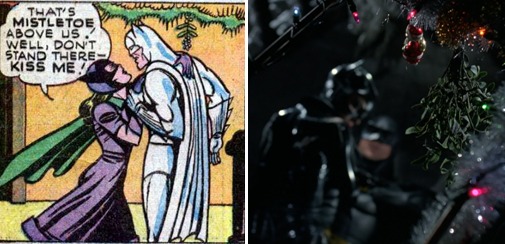
Batman's cape transforms into a glider, which he then uses to make a quick descent from the rooftop down to street level. Batman has used gliders many times in the comics, one example being Batman: Year One. He's also used his cape as a glider in some stories, as seen here in 'Batman Versus Eclipso' (Brave and the Bold #64, March 1966).
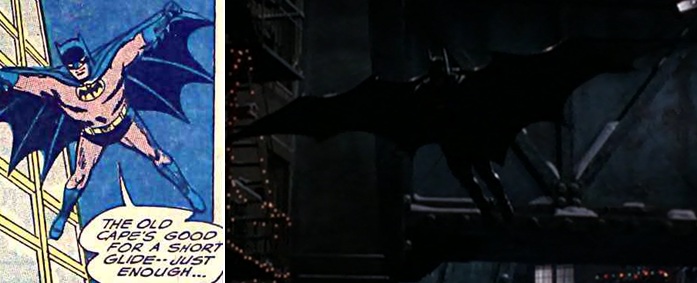
We are then treated to a big action set piece involving the Batmobile. This version is based on Anton Furst's Academy Award winning designs for the 1989 film. It has occasionally appeared in the Batman comics, as seen here in the Red Hood: The Lost Days (2010-2011) miniseries.
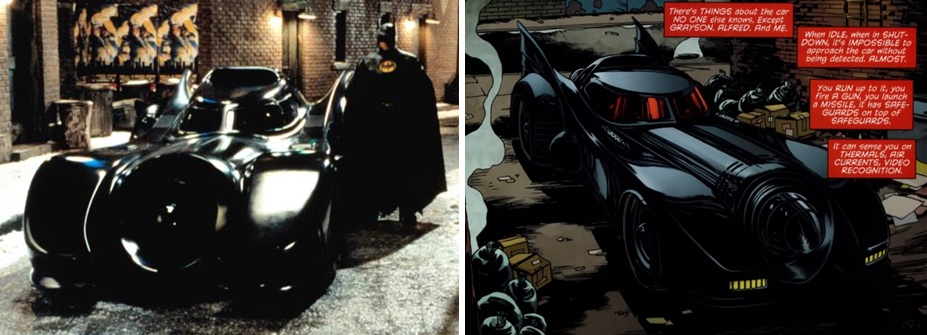
This Batmobile has the ability to transform into the Batmissile, a slender torpedo-shaped vehicle capable of advanced speeds and manoeuvrability. The Bat-Missile in the comics was a similar looking craft, equally suited to advanced speeds and manoeuvrability. It was sent backwards in time by the Batman of the future to aid his present-day counterpart, as depicted in the Silver Age story 'The Mysterious Bat-Missile' (Batman #105, February 1957). In this story, Batman converts the Bat-Missile into a Batmobile by adding "wheels and a little trim" to its sides. At the end of the story he disengages the Bat-Missile portion from the rest of the Batmobile. The Batmissile in the movie can also be connected or disconnected from the rest of the Batmobile.

The Bat-Missile in the comics was capable of travelling through solid objects, including buildings. The scene in the movie where the Batmissile passes through the narrow alley between two buildings is possibly an oblique reference to that function.
Bruce Wayne is shown to be a skilled mechanic in Batman Returns, and he takes it upon himself to repair the Batmobile after it is damaged during the chase sequence. The Bruce Wayne in the comics is also a skilled mechanic. This is perhaps best demonstrated in Batman: Prey (1990-1991) when he personally constructs the first Batmobile.
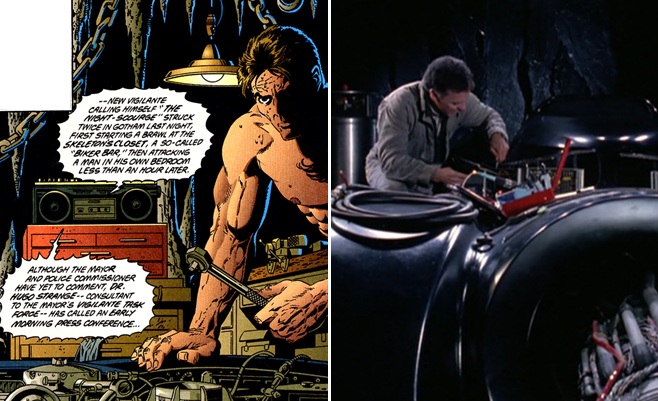
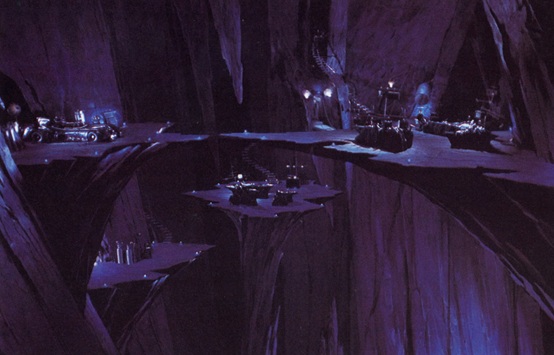 The workshop area where the Batmobile is repaired is merely one of several distinct areas within the Batcave. The other areas include the crime lab and armoury. The crime lab contains surveillance and signal-jamming equipment, as well as a microfiche reader that Bruce uses to research old microfilm data pertaining to previous Red Triangle Gang attacks. In the Golden Age comics, Batman kept all of his crime files stored on microfilm, which he could then peruse with the aid of the equipment in the Batcave.
The workshop area where the Batmobile is repaired is merely one of several distinct areas within the Batcave. The other areas include the crime lab and armoury. The crime lab contains surveillance and signal-jamming equipment, as well as a microfiche reader that Bruce uses to research old microfilm data pertaining to previous Red Triangle Gang attacks. In the Golden Age comics, Batman kept all of his crime files stored on microfilm, which he could then peruse with the aid of the equipment in the Batcave.
The armoury is a vault accessed by a drawbridge. It contains Batman's weapons and costumes. The spare Batsuits are shown hanging on a clothes rack.
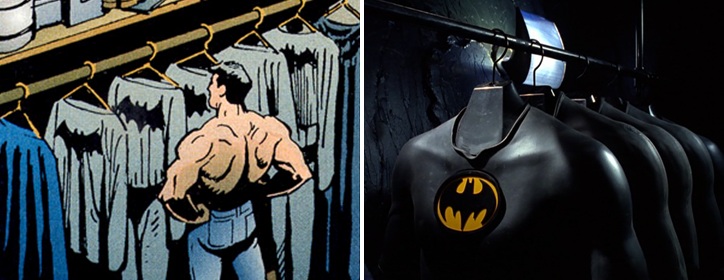
Alfred interrupts Bruce's work in the Batcave to inform him he's been invited to Shreck's masquerade ball. In the comics Alfred plays an important role in helping maintain Bruce's public playboy persona by organising his diary of social events.
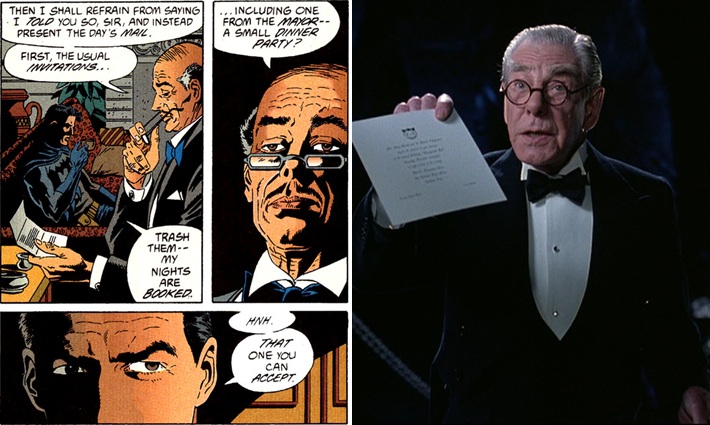
While attending such events, Bruce usually dresses in a fashionable black tuxedo.
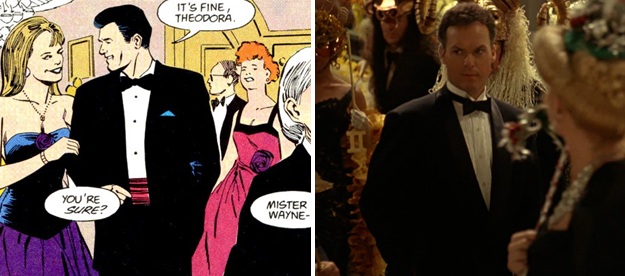
Unfortunately the party is interrupted when the Penguin shows up, announcing his plan to take revenge against Gotham by killing all the firstborn children. The Penguin has attempted several similarly ruthless schemes in the comics. In Detective Comics Annual #1 (August 1988) he tries to unleash rabid robins on the city in order to spread a lethal pathogen that will kill all the women and children. When a henchman asks him if he will really do it, Cobblepot sadistically replies that he would "love" to.
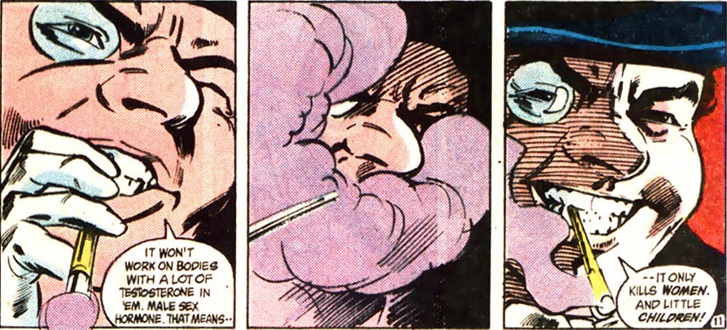
Bruce quickly changes into his Batsuit and races to save the children. The image of his shadow projected against the wall is typical of the comics.

So is the letter he sends to the Penguin, signed with the bat emblem.

Cobblepot then puts into action his contingency plan, which involves sending out his penguin commandos to destroy Gotham. The Penguin's modus operandi in the comics has always involved the use of birds. In early comics, he simply trained avians to do his bidding. In the Post-Crisis comics, he uses electronic devices to manipulate them, implanting wave modulator mechanisms inside their skulls and transmitting sonic signals to control their actions.
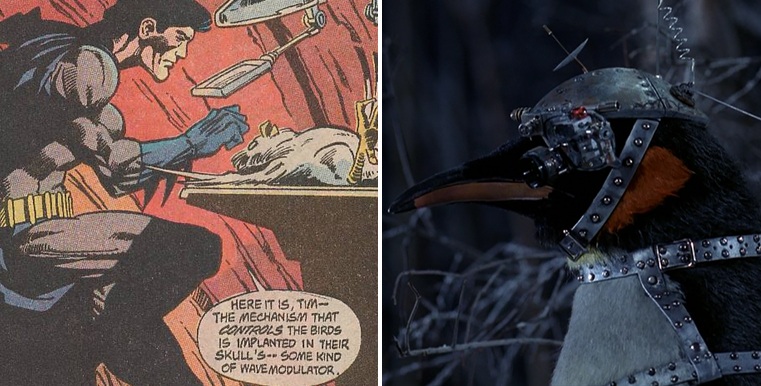
The penguin commandoes in the film are regular penguins with explosive weapons strapped to their backs. In the Pre-Crisis comics in particular, Cobblepot would frequently use penguins in a similar manner. Sometimes they were real penguins with explosives strapped to their backs, as seen here in 'The Penguin on Parole' (Batman #38, December 1946).
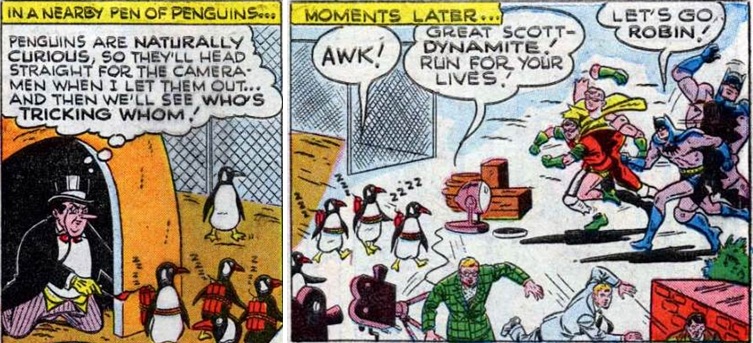
In other stories he used robotic penguins primed to explode upon reaching their target, as seen here in 'Pieces of Penguin!' (Batman #374, August 1984).
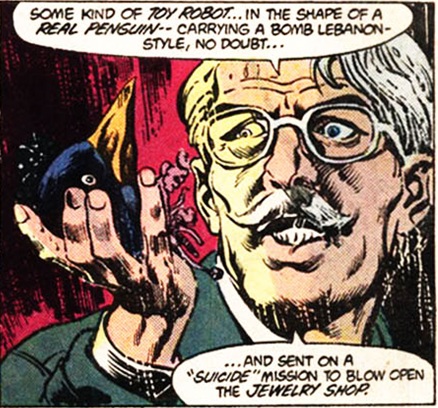
Possibly influenced by the film, the recent story Penguin: Pain and Prejudice features Cobblepot hatching a plan very similar to the one in Batman Returns. In this story, Cobblepot blames the people of Gotham for the mistreatment he's suffered throughout his life and sets out to avenge himself by killing all the children in the city.
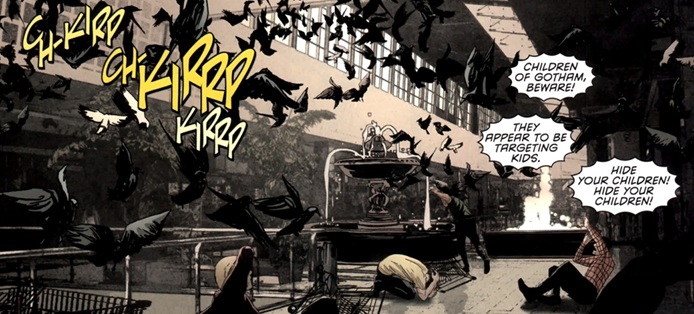
To this end, he dispatches penguin-shaped rockets that emit sonic signals to incite flocks of birds to attack the people. In the movie, Cobblepot tries something similar using real penguins armed with rockets and guided by control signals. In both stories, his plans are foiled when Batman disrupts the source of the signal.
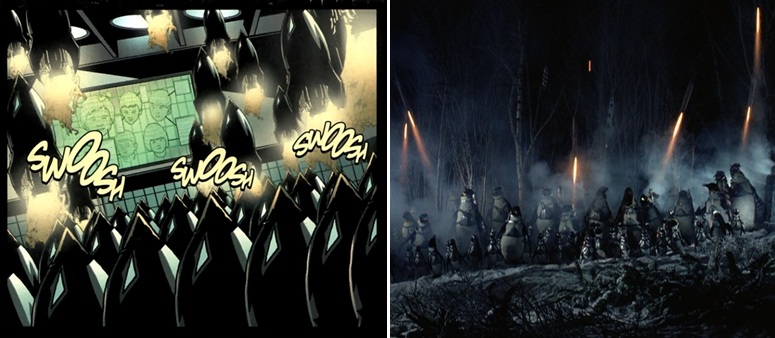
Batman ventures into the sewers in the Batskiboat to try and track down the Penguin's hidden base. The Batskiboat is Burton's version of the Batboat. Its hydrofoil design is similar to the Batboat seen in Strange Apparitions.

Some later comics have featured Batboats more closely resembling the one in the movie.
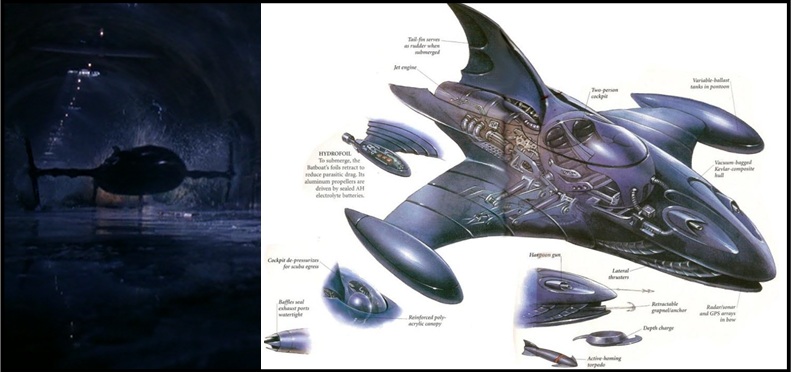
Batman is able to track down the whereabouts of the Penguin's secret hideout in the film by tracing the source of the signal Cobblepot uses to control the birds. This is the same method the Batman in the comics uses to locate the Penguin's hidden base in The Penguin Affair.
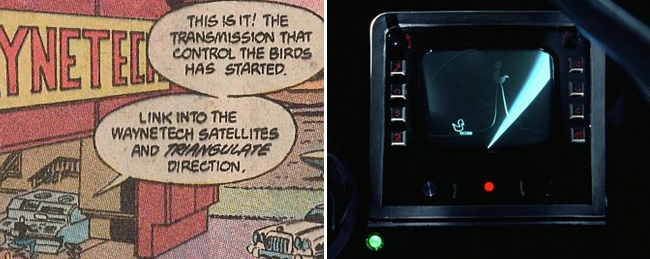
Batman uses a sonic device to disrupt Cobblepot's control signal and lure the penguin commandos back to the zoo. The Batman, in the comics, uses a similar device in The Penguin Affair.
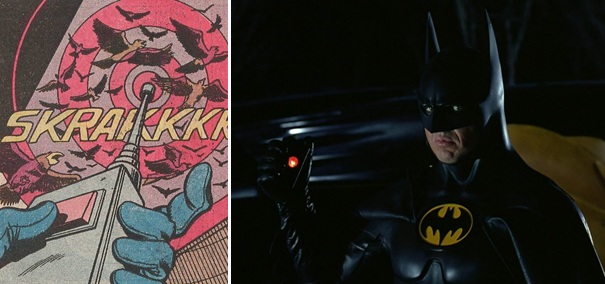
Batman and the Penguin's final fight scene plays out pretty much the way all their fights in the comics do: the Penguin attacks Batman with his blade umbrella, only for Batman to casually disarm and defeat him without breaking a sweat.
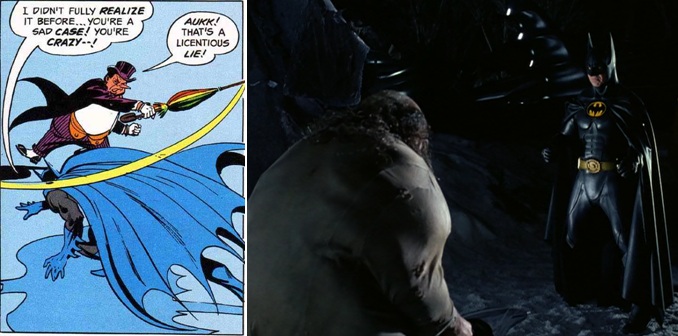
The fight ends when bats emerge from the wreckage of the Batskiboat and swarm around the Penguin. The Penguin in the Golden Age comics exhibited a fear of bats on more than one occasion and would become similarly flustered whenever they swarmed around him.
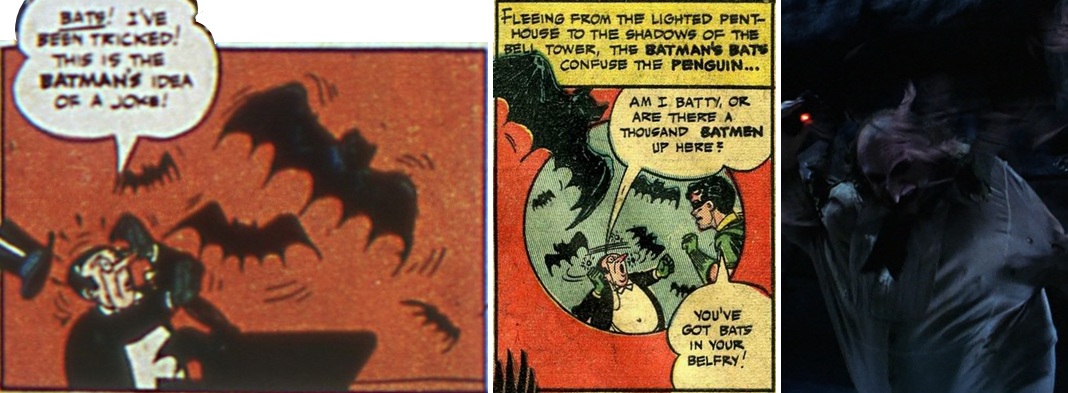
After dealing with the Penguin, Batman then has to confront Catwoman and try to prevent her from killing Shreck. This scene seems to have been inspired by the finale of Catwoman: Her Sister's Keeper, where Batman has to prevent Catwoman from killing Captain Strunk, a corrupt policeman who assaulted her friend, Holly.
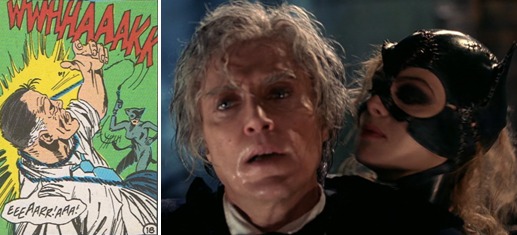

In both the comic and the movie, Batman tells Catwoman her prey must be dealt with by the law. And in both stories Selina replies that the law won't bring him to justice.
Batman proceeds to unmask himself in the movie. This echoes a similar scene from the end of 'The Autobiography of Bruce Wayne' (Brave and the Bold #197, April 1983), where Batman removes his mask to reveal his true identity to Selina. In both stories, a third character is present at the time. In the comic it's Scarecrow, in the film it's Shreck.
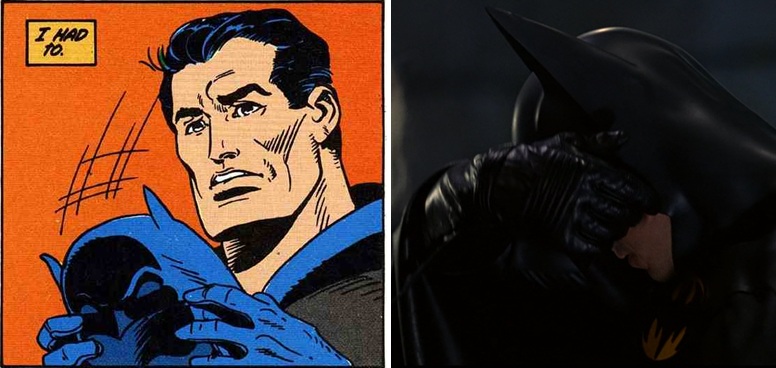
As mentioned earlier, the Selina in the comics reformed during the Golden Age. She also reformed in the Bronze Age Earth-One canon. In both instances though, she inevitably found herself being drawn back into her life as Catwoman. This happened on several occasions, and Batman was always there to try and curb her recidivistic habits. But even he found it hard to understand her capricious nature. The moment in Batman Returns where she suddenly slashes him across the face after he tries to help her is a perfect example of that caprice.

At the end of Catwoman: Her Sister's Keeper Batman succeeds in preventing Selina from killing Captain Strunk. He is not so successful in the movie, and the film ends on a downbeat note with Alfred chauffeuring Bruce back to Wayne Manor in his Rolls-Royce. The one consolation at the end of the film is that Bruce still has his trusty butler to look out for him, just as he's always done in the comics.

And that concludes this analysis of Tim Burton's Batman Returns.
Discuss this feature here in the forum
comments powered by Disqus












by Silver Nemesis
by Silver Nemesis
by Silver Nemesis
by The Joker
by The Joker
by The Joker
by The Joker
by The Dark Knight
by Silver Nemesis
by The Dark Knight